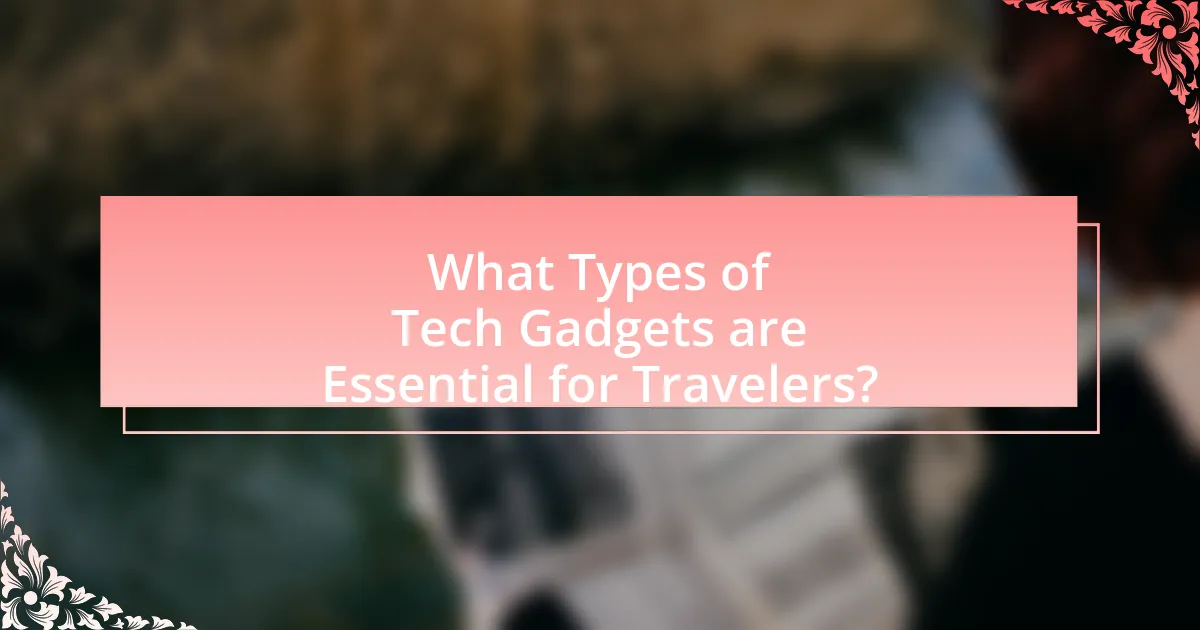The article focuses on the best tech gadgets for travel enthusiasts, highlighting essential devices that enhance convenience, connectivity, and comfort during travel. Key gadgets discussed include portable chargers, noise-canceling headphones, travel routers, and smart luggage, each designed to improve the travel experience by ensuring devices remain powered, blocking ambient noise, and providing secure internet access. The article also emphasizes important features to consider when selecting travel gadgets, such as portability, durability, battery life, and multifunctionality, while addressing the role of technology in modern travel planning and safety. Additionally, it provides insights on maintaining and protecting gadgets while traveling, ensuring they remain functional and efficient throughout the journey.

What are the Best Tech Gadgets for Travel Enthusiasts?
The best tech gadgets for travel enthusiasts include portable chargers, noise-canceling headphones, and travel routers. Portable chargers, such as the Anker PowerCore series, provide essential power for devices on the go, with some models offering multiple charges for smartphones and tablets. Noise-canceling headphones, like the Sony WH-1000XM4, enhance travel experiences by blocking out ambient noise, making flights and train rides more enjoyable. Travel routers, such as the GL.iNet GL-MT1300, enable secure internet access and allow multiple devices to connect to a single Wi-Fi source, which is particularly useful in hotels or public spaces. These gadgets are designed to enhance convenience, connectivity, and comfort for travelers.
How do these gadgets enhance the travel experience?
Travel gadgets enhance the travel experience by providing convenience, connectivity, and efficiency. For instance, portable chargers ensure that devices remain powered throughout the journey, allowing travelers to access maps, communicate, and document their experiences without interruption. Noise-canceling headphones improve comfort during long flights or train rides by blocking out ambient noise, making travel more enjoyable. Additionally, smart luggage with built-in GPS tracking helps prevent loss and provides peace of mind. According to a survey by the International Air Transport Association, 70% of travelers reported that technology significantly improves their travel experience, highlighting the importance of these gadgets in modern travel.
What features should travelers look for in tech gadgets?
Travelers should look for portability, durability, battery life, and multifunctionality in tech gadgets. Portability ensures that devices are lightweight and easy to carry, which is crucial for travel. Durability is important as gadgets must withstand various environments and potential impacts during trips. Long battery life is essential to avoid frequent recharging, especially during long journeys or in remote areas. Multifunctionality allows a single device to serve multiple purposes, reducing the need to carry several gadgets. For example, a portable charger that also functions as a flashlight and a data storage device maximizes utility while minimizing bulk.
How do these features improve convenience and efficiency?
The features of tech gadgets for travel enthusiasts improve convenience and efficiency by streamlining travel processes and enhancing user experience. For instance, portable chargers ensure devices remain powered during long journeys, eliminating the inconvenience of dead batteries. Smart luggage with built-in GPS tracking allows travelers to monitor their bags in real-time, reducing the stress of lost luggage. Additionally, noise-canceling headphones enhance focus and relaxation during travel, making it easier to enjoy the journey. These features collectively save time and reduce hassle, allowing travelers to concentrate on their experiences rather than logistical challenges.
Why is technology important for modern travelers?
Technology is important for modern travelers because it enhances convenience, safety, and connectivity during their journeys. For instance, mobile applications allow travelers to book accommodations, navigate unfamiliar cities, and access real-time information about flights and transportation. According to a survey by the International Air Transport Association, 70% of travelers use their smartphones to assist with travel planning and management. Additionally, technology such as portable chargers and noise-canceling headphones improves the travel experience by ensuring devices remain powered and providing comfort in noisy environments. Overall, technology streamlines the travel process and enriches the overall experience for travelers.
What role does technology play in travel planning?
Technology plays a crucial role in travel planning by providing tools and resources that streamline the process, enhance decision-making, and improve overall travel experiences. Digital platforms such as travel booking websites and mobile applications allow users to compare prices, read reviews, and access real-time information about flights, accommodations, and activities. According to a 2021 report by Statista, 83% of travelers use online resources for travel planning, highlighting the reliance on technology for informed choices. Additionally, advancements in artificial intelligence and machine learning enable personalized recommendations, making it easier for travelers to find options that suit their preferences and budgets.
How can tech gadgets improve safety during travel?
Tech gadgets can improve safety during travel by providing real-time information, enhancing communication, and offering security features. For instance, GPS devices and smartphone apps can help travelers navigate unfamiliar areas, reducing the risk of getting lost or entering unsafe neighborhoods. Additionally, portable chargers ensure that devices remain powered, allowing for continuous access to emergency contacts and safety apps. Furthermore, gadgets like personal safety alarms and smart luggage with tracking capabilities can deter theft and assist in recovery if lost. According to a study by the International Air Transport Association, 70% of travelers feel more secure when using technology that enhances their awareness and connectivity while on the move.

What Types of Tech Gadgets are Essential for Travelers?
Essential tech gadgets for travelers include portable chargers, noise-canceling headphones, universal travel adapters, and compact cameras. Portable chargers ensure devices remain powered during long journeys, with many models providing multiple charges for smartphones and tablets. Noise-canceling headphones enhance travel comfort by blocking out ambient noise, making them ideal for flights and public transport. Universal travel adapters allow travelers to connect their devices in various countries, accommodating different plug types and voltages. Compact cameras offer high-quality photography without the bulk of traditional cameras, enabling travelers to capture memories easily. These gadgets enhance convenience, connectivity, and enjoyment during travel.
Which gadgets are best for communication while traveling?
Smartphones are the best gadgets for communication while traveling due to their multifunctionality and global connectivity. They enable voice calls, video chats, instant messaging, and access to social media platforms, making it easy to stay in touch with family and friends. Additionally, smartphones can connect to Wi-Fi and cellular networks worldwide, allowing travelers to communicate without relying on traditional phone lines. According to a report by Statista, as of 2021, there were over 3.8 billion smartphone users globally, highlighting their widespread adoption and utility for communication.
What are the top smartphones for international travel?
The top smartphones for international travel include the Apple iPhone 14 Pro, Samsung Galaxy S23 Ultra, and Google Pixel 7 Pro. These smartphones are favored for their global compatibility, robust camera systems, and long battery life. The iPhone 14 Pro supports multiple LTE bands and has excellent photo capabilities, making it ideal for capturing travel memories. The Samsung Galaxy S23 Ultra offers extensive storage options and a powerful zoom feature, which is beneficial for photography in diverse environments. The Google Pixel 7 Pro is known for its exceptional software optimization and camera performance, particularly in low-light conditions. These features collectively enhance the travel experience by ensuring connectivity, capturing high-quality images, and providing reliable performance across various regions.
How do portable Wi-Fi devices enhance connectivity?
Portable Wi-Fi devices enhance connectivity by providing reliable internet access in various locations, especially where traditional networks are unavailable. These devices create a personal hotspot that allows multiple users to connect simultaneously, ensuring that travelers can stay connected for work, navigation, and communication. According to a report by the International Telecommunication Union, mobile broadband subscriptions have increased significantly, indicating a growing reliance on portable internet solutions for seamless connectivity while on the go.
What gadgets are useful for navigation and exploration?
GPS devices are essential gadgets for navigation and exploration, providing accurate location data and route guidance. These devices utilize satellite signals to determine precise positioning, enabling users to navigate unfamiliar terrains effectively. For instance, handheld GPS units like the Garmin GPSMAP series are widely used by hikers and outdoor enthusiasts for their durability and detailed topographic maps. Additionally, smartphone applications such as Google Maps and Waze offer real-time navigation and traffic updates, making them invaluable for urban exploration. The reliability of GPS technology is supported by its widespread adoption in various fields, including aviation and maritime navigation, demonstrating its effectiveness in guiding users safely to their destinations.
How do GPS devices compare to smartphone navigation apps?
GPS devices offer dedicated navigation capabilities, while smartphone navigation apps provide multifunctional features. GPS devices typically have superior accuracy and reliability in remote areas due to their specialized hardware and satellite connectivity. In contrast, smartphone apps leverage cellular data and Wi-Fi, which can enhance features like real-time traffic updates and integration with other applications. According to a study by the University of California, Berkeley, GPS devices maintain a 95% accuracy rate in rural settings, whereas smartphone apps can experience up to a 20% drop in accuracy in similar environments due to reliance on signal strength.
What are the benefits of using travel apps for exploration?
Travel apps enhance exploration by providing real-time information, personalized recommendations, and streamlined navigation. These applications allow users to access maps, local attractions, and reviews instantly, facilitating informed decision-making during trips. For instance, a study by the International Journal of Information Management found that 70% of travelers rely on mobile apps for itinerary planning and discovering new destinations, highlighting their significance in modern travel experiences. Additionally, travel apps often include features like offline access and language translation, further enriching the exploration process and making it more accessible for users worldwide.

How to Choose the Right Tech Gadgets for Your Travel Needs?
To choose the right tech gadgets for your travel needs, assess your specific requirements based on the type of travel you plan to undertake. Consider factors such as portability, battery life, functionality, and compatibility with your existing devices. For instance, if you frequently travel for business, a lightweight laptop with long battery life and robust security features is essential. In contrast, if you are an adventure traveler, a durable, waterproof action camera may be more suitable. Research shows that 70% of travelers prioritize battery life and weight when selecting gadgets, indicating the importance of these features in travel tech decisions.
What factors should you consider when selecting travel gadgets?
When selecting travel gadgets, consider portability, functionality, battery life, and compatibility. Portability ensures that the gadget is lightweight and easy to carry, which is crucial for travelers who often have limited space. Functionality refers to the gadget’s ability to perform multiple tasks, enhancing convenience during travel. Battery life is essential, as longer-lasting devices reduce the need for frequent recharging, especially in remote areas. Compatibility with other devices, such as smartphones or laptops, ensures seamless integration and usability. These factors collectively enhance the travel experience by providing reliable and efficient tools for various needs.
How does weight and size impact gadget selection?
Weight and size significantly impact gadget selection for travel enthusiasts by influencing portability and usability. Lighter and more compact gadgets are preferred as they reduce the overall load during travel, making it easier to carry and manage. For instance, a study by the International Air Transport Association indicates that travelers prioritize lightweight devices to comply with airline baggage restrictions and enhance mobility. Additionally, smaller gadgets often fit better in limited luggage space, allowing travelers to maximize their packing efficiency. Thus, the weight and size of gadgets directly affect their practicality and convenience for those on the move.
What is the importance of battery life in travel gadgets?
Battery life is crucial in travel gadgets because it directly impacts their usability and reliability during trips. Travel often involves extended periods away from power sources, making long-lasting battery life essential for devices like smartphones, cameras, and portable chargers. For instance, a smartphone with a battery life of at least 10 hours allows users to navigate, communicate, and capture memories without frequent recharging, which is vital for maintaining connectivity and convenience while traveling. Additionally, according to a survey by Statista, 67% of travelers prioritize battery life when selecting tech gadgets, highlighting its significance in enhancing the overall travel experience.
How can you ensure compatibility with international standards?
To ensure compatibility with international standards, select tech gadgets that are certified by recognized organizations such as the International Organization for Standardization (ISO) or the Institute of Electrical and Electronics Engineers (IEEE). These certifications indicate that the products meet specific safety, quality, and performance criteria accepted globally. For example, gadgets with CE marking comply with European safety standards, while those with FCC certification meet U.S. regulations. Additionally, verify that the devices support multiple voltage ranges (e.g., 100-240V) and have universal plug adapters to accommodate different electrical outlets worldwide. This approach guarantees that the gadgets will function properly in various countries, minimizing the risk of damage or malfunction during travel.
What are the common charging standards around the world?
The common charging standards around the world include USB Type-A, USB Type-B, USB Type-C, and various proprietary standards such as Apple’s Lightning connector. USB Type-C is increasingly becoming the universal standard due to its versatility, supporting power delivery and data transfer at high speeds. According to the USB Implementers Forum, USB Type-C can deliver up to 100 watts of power, making it suitable for charging a wide range of devices, from smartphones to laptops. Additionally, many countries have adopted these standards, facilitating compatibility and reducing the need for multiple chargers while traveling.
How can adapters and converters help with compatibility?
Adapters and converters enhance compatibility by allowing devices from different regions or with varying specifications to connect and function together. For instance, a power adapter can enable a device designed for a specific voltage to operate in a region with a different voltage standard, preventing damage and ensuring functionality. Additionally, converters can change signal formats, such as HDMI to VGA, enabling devices with incompatible ports to communicate effectively. This compatibility is crucial for travelers who often encounter diverse electrical systems and device standards across different countries.
What are some tips for maintaining your tech gadgets while traveling?
To maintain your tech gadgets while traveling, ensure you use protective cases to prevent physical damage. Protective cases are designed to absorb shocks and prevent scratches, which is crucial in the unpredictable environments of travel. Additionally, regularly clean your devices with microfiber cloths to avoid dust and grime buildup, as this can affect performance and longevity. Keeping gadgets charged is essential; use portable chargers to ensure devices remain powered during long trips, as a dead battery can render them useless. Lastly, back up important data before traveling to safeguard against loss or damage, as studies show that 30% of travelers experience device loss or theft.
How can you protect your gadgets from damage during travel?
To protect your gadgets from damage during travel, use padded cases and sleeves specifically designed for each device. These protective accessories absorb shocks and prevent scratches, significantly reducing the risk of damage. For instance, a study by the Consumer Electronics Association found that using protective cases can decrease the likelihood of device failure by up to 70%. Additionally, keep gadgets in carry-on luggage rather than checked bags to avoid exposure to extreme temperatures and rough handling, which can lead to malfunctions.
What are the best practices for keeping gadgets charged on the go?
To keep gadgets charged on the go, use portable power banks, which provide a reliable source of energy for devices when outlets are unavailable. Selecting a power bank with a high capacity, such as 20,000 mAh or more, ensures multiple charges for smartphones and tablets. Additionally, utilizing fast-charging cables can significantly reduce charging time, allowing for quicker power boosts during travel. It is also advisable to turn off unnecessary features on devices, such as Bluetooth and location services, to conserve battery life. According to a study by the International Energy Agency, optimizing device settings can extend battery longevity by up to 30%.


